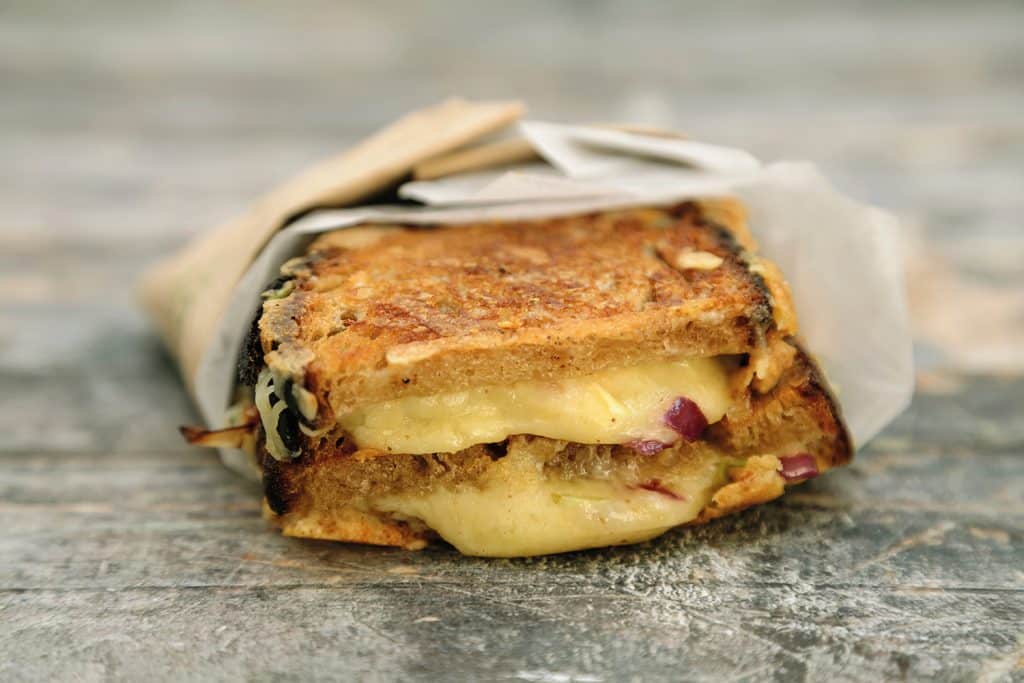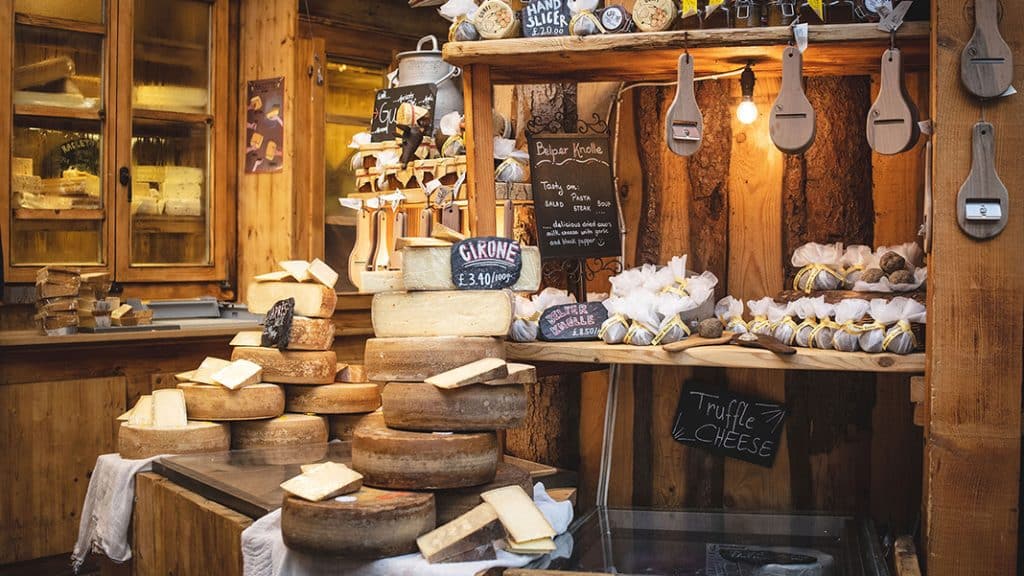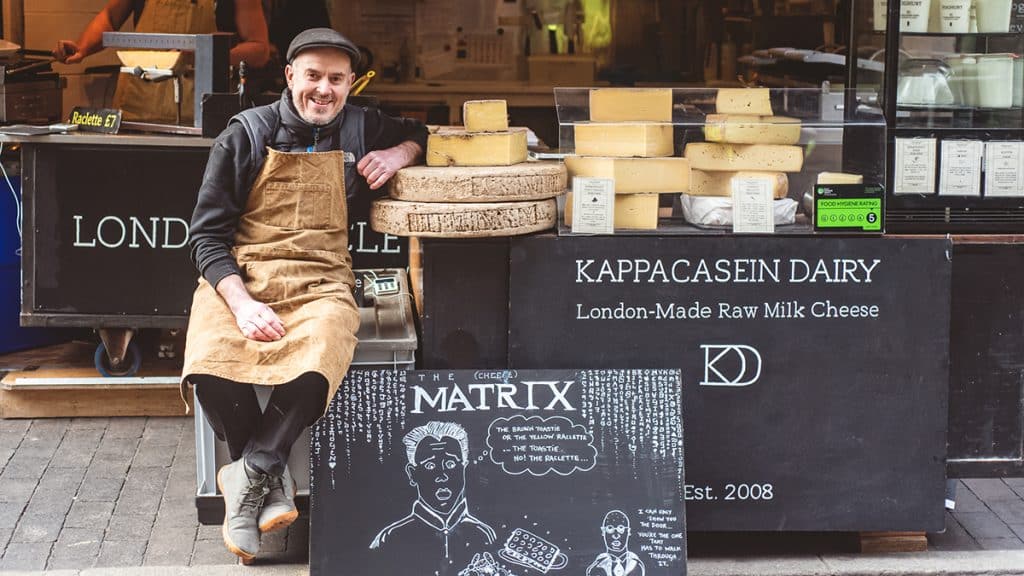Hot mess
Borough Market’s cheesemongers on the joys of cooking with cheese


“YOU CAN FIND A CHEESE FOR ALMOST ANY DISH, CONSIDERING HOW MANY FLAVOUR PROFILES AND TEXTURES THERE ARE”
Words: Tomé Morrissy-Swan
Cheese is among the most versatile of ingredients. And seasonal, too. In spring and summer, I prefer a fresh goat’s cheese, perhaps a cooling burrata; come winter, sturdier mountain cheeses and pungent blues fill my fridge.
Cooking with cheese also changes throughout the year. In summer it might be fresh mozzarella in a salad, or halloumi on the barbecue. In the colder months, it’s all about melting: an oozing mac and cheese, a comforting toastie, or a bubbling baked camembert.
“Cheese is probably the best ingredient in the world for cooking,” says Bronwen Percival, technical director at Neal’s Yard Dairy. While cheese in its “native state” is wonderful, Bronwen marvels at the way it can transform into something completely different. “When you change the temperature of cheese, the taste changes dramatically.”
Coles Loomis, manager of Jumi Cheese, which specialises in Swiss cheeses, agrees. Cheese adds a nuanced and exciting flavour profile to any dish, she explains – the reason we grate parmesan on pasta, for example, is to add umami. Texture is vital, too. “Cheese adds a lovely creaminess to sauces, or a nice melt in baked dishes. You can find a cheese for almost any dish you make, considering how many different flavour profiles and textures the world of cheese has to offer.”

Take the fondue, that Swiss classic, the pinnacle of rib-sticking, restorative mountain food, and one of the last truly communal meals in Europe. It’s the prime example, perhaps, of melted cheese, right down into a thick, viscous sauce. “Every cheesemonger will have a different answer for what cheese makes the best fondue,” Coles explains. The traditional choice is gruyère or emmentaler, but she recommends shredding a mix of three cheeses, for balance. One hard and nutty, one semi-hard and buttery, and one sharp and slightly acidic. From Jumi’s stock, she suggests schlossberger, aarewasser and emmentaler. Melt them down low and slow, add a splash of white wine and a little minced garlic and herbs, says Coles, and “serve your fondue with anything you want to dip in molten cheese.”
Raclette is another wonderful cooker which can be melted over boiled potatoes, roasted vegetables, meat and gherkins. Cheese expert and filmmaker Sam Wilkin likes to use Yarlington for a tartiflette-inspired take on a Shropshire classic, the fidgety pie. Made by King Stone Dairy in Gloucestershire and matured by Neal’s Yard Dairy, Yarlington is a bright, milky, cider-washed cheese inspired by reblochon. Bacon, apples, onions and potatoes are baked with the cheese “into a disgraceful mess,” Sam jokes.
Though Swiss and Italian cheeses may be renowned for cooking, at Neal’s Yard Dairy, British cheeses are the specialty, and they shouldn’t be overlooked when it comes to the kitchen, says Bronwen. A good mature cheddar is great in a mac and cheese, while adding some red leicester to the mix gives it that retro orange hue. She recommends adding cheddar curds if you want more of a stretchy melt. For burgers, Bronwen says an aged farmhouse cheddar can lose moisture and become crumbly. Try “something younger, but still a classic British cheese, like a wensleydale that has freshness, milkiness, meltability and stretchability, but is not going to interfere with the experience of eating a burger.”

A cheese toastie is a classic for a reason. The combination of crisp, toasted bread and molten cheese is about as comforting and nostalgic as food gets. But with a little effort, even this humble sandwich can be elevated. Bill Oglethorpe, owner of Kappacasein, is about as qualified as anyone to impart knowledge on the grilled cheese. Not only does he run the Borough Market shop that serves the best toasties in the city, he makes much of the cheese that goes into it at his dairy in Bermondsey.
Kappacasein’s legendary toasties are made with a blend of Montgomery’s Cheddar, Ogleshield, a raclette-like cheese partially named after Bill, who developed the recipe, and other hard cheeses, including his Bermondsey Hard Pressed, which is similar in style to gruyère. Bill says the nuttiness of the Montgomery’s combines wonderfully with the milky, savoury Ogleshield and the fruity acidity of the sourdough. When making at home, he recommends thin slices of sourdough bread and a generous amount of cheese, always grated, which melts better, the outer layer of cheese oozing through the bread to help it go deliciously oily (he doesn’t use any butter), and the cheese in the middle retaining some texture. A little raw sliced onion helps balance the rich, fatty cheese. Equipment-wise, all you need is a toastie machine, or a frying pan with a weight. Simple yet luxurious.
While almost any cheese cooks well, Bronwen says that one of the most common misconceptions is that good, artisan cheese is exclusively for the cheeseboard. “Using great quality cheese as a cooking ingredient elevates dishes like nothing else can,” she says. “Don’t be afraid to spend up on cheese as an ingredient. It will change your life.”
Tips for storing cheese
It’s a Christmas tradition to stock up on cheese, but around two million kilograms are thrown away each year. This can easily be prevented. Firstly, store cheese properly. Wrap it in greaseproof paper or cheesemonger’s waxed paper and keep it at the back of the fridge, or in the vegetable compartment, which has a good mixture of humidity and coolness, says Bill Oglethorpe. For hard cheeses, the freezer’s your friend (a sealed box of grated hard cheese is always a good idea), although softer cheeses shouldn’t be frozen.
Bronwen Percival adds that smaller pieces of hard cheese are liable to dry out, so she routinely does a fridge clean-out, adding bits of different hard cheese to a mac and cheese. “Don’t be afraid to combine what you’ve got,” adds Coles Loomis. “Any recipe is enhanced by a lump of dried out cheese that’s long been forgotten about. It’s basically condensed, fatty flavour that will also improve your dish’s texture. Chuck it in a sauce or stew.”
If all else fails and your cheese has grown mould despite being kept in the fridge, fear not. Unless it’s a soft cheese, just scrape it off, and you’ll uncover a “really pristine piece of cheese,” says Bronwen.